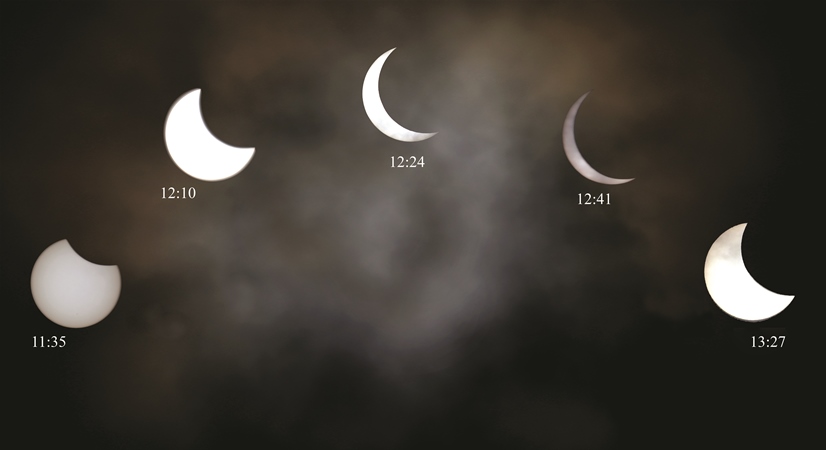Solar eclipse culturally charged in Nepali society

By Aashish Mishra
Kathmandu, June 22: Nepal witnessed its first solar eclipse of the year on Sunday. It was a partial eclipse that began at 10.54 AM in Kathmandu, 10.52 AM in Pokhara, 10.52 AM in Bhadrapur, 10.56 AM in Janakpur and 10.54 AM in Mahendranagar. The eclipse was visible from all over Nepal and blocked out 81 per cent (in Bhadrapur) to 93 per cent (in Limpiyadhura)of the sun over the country’s sky, according to information provided by BP Koirala Memorial Planetarium, Observatory and Science Museum (BPKMPOSM) Development Committee.
Lasting well over three hours, Nepal, as well as most other parts of Asia, northern and eastern Africa, south-eastern Europe and northern Australia experienced only a partial solar eclipse, as per the Committee. However, people in places like Congo, Sudan, Ethiopia, Yemen, Oman, southern Pakistan, north-western India and south-eastern China were able to witness the rare annular eclipse, where the centre of the sun got covered leaving only its outer edge visible in a phenomenon known as the ring of fire.
But whether total, partial or annular, solar eclipses hold a great cultural significance for Hindu Nepalis. “People refrain from eating, going out, engaging in financial transactions or sexual activities,” informed astrologer Suresh Raj Giri.
This is exactly what Maitreya Timilsina did. He and his wife woke up at 4 in the morning, finished their daily puja, cleaned the house, prepared the food, woke their four children up at 8 and got done with everything before 10. “We rushed so much because we shouldn’t eat or be doing the dishes during the eclipse,” Timilsina said.
Scientifically, solar eclipses are just celestial events that occur when the moon comes between the Earth and the sun, casting its shadow and fully or partially blocking the sun’s light from reaching our planet. But astrologically, they are much more significant and believed to affect people’s lives. According to Giri, Sunday’s eclipse will particularly impact individuals whose star sign is Gemini, as per the Nepali horoscope system. “They need to be very careful and cautious,” he said.
Ghanashyam Shrestha is a Gemini and is a big believer in horoscopes. That is why he spent Sunday morning going around Kathmandu Valley on his motorcycle and giving alms to the poor and needy. “I was told by my fortune-teller to give rice, clothes and money to the helpless in order to minimise any negative effect the eclipse may have on me and my family.”
However, Giri stressed that the eclipse’s impact on a person would depend on specific factors such as his/her time of birth, planetary alignments, etc.
It must be noted though that there is no scientific evidence showing that eclipses affect humans in any way.
Aside from such aspects, eclipses are also beautiful spectacles that stir the interest of hundreds of thousands of people around the world. They are also broadcast on televisions and pictures published in newspapers and websites. But one must never directly view them without proper precautions.
As stated by BPKMPOSM Development Committee, looking at the eclipse with naked eyes, binoculars or telescopes or using X-ray plates, blackened mirror or water to reflect and view it can cause permanent eye damage. Instead, we should use
protective goggles coated with special dark-coloured metal that are used by mountain climbers.
Moreover, while Nepal could not experience an annular eclipse this time, it will be able to experience it on February 17, 2064, from the south-eastern part of State 1, as informed by Nepal Astronomical Society (NASO) in a press release, which also stated that the last time such an eclipse was visible from Nepal was on November 23, 1965, which was also from State 1.
Sunday’s eclipse was also special because it coincided with the summer solstice i.e. the longest day of the year.
Recent News

Do not make expressions casting dout on election: EC
14 Apr, 2022
CM Bhatta says may New Year 2079 BS inspire positive thinking
14 Apr, 2022
Three new cases, 44 recoveries in 24 hours
14 Apr, 2022
689 climbers of 84 teams so far acquire permits for climbing various peaks this spring season
14 Apr, 2022
How the rising cost of living crisis is impacting Nepal
14 Apr, 2022
US military confirms an interstellar meteor collided with Earth
14 Apr, 2022
Valneva Covid vaccine approved for use in UK
14 Apr, 2022
Chair Prachanda highlights need of unity among Maoist, Communist forces
14 Apr, 2022
Ranbir Kapoor and Alia Bhatt: Bollywood toasts star couple on wedding
14 Apr, 2022
President Bhandari confers decorations (Photo Feature)
14 Apr, 2022









